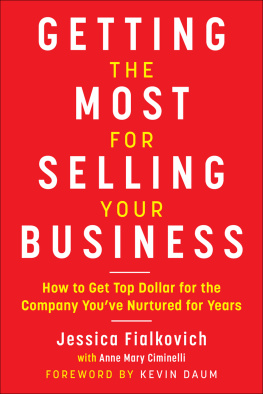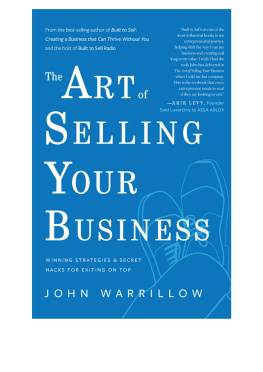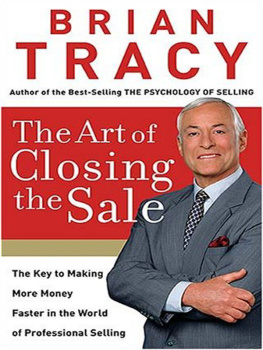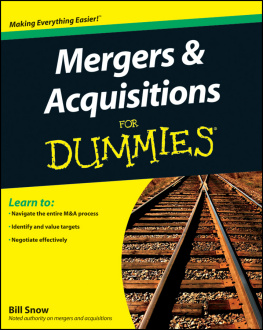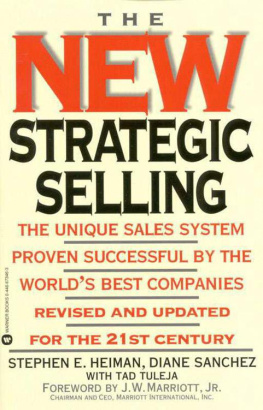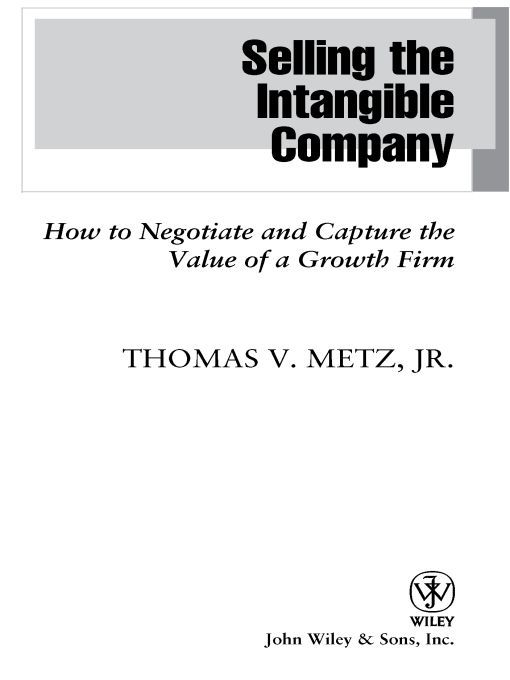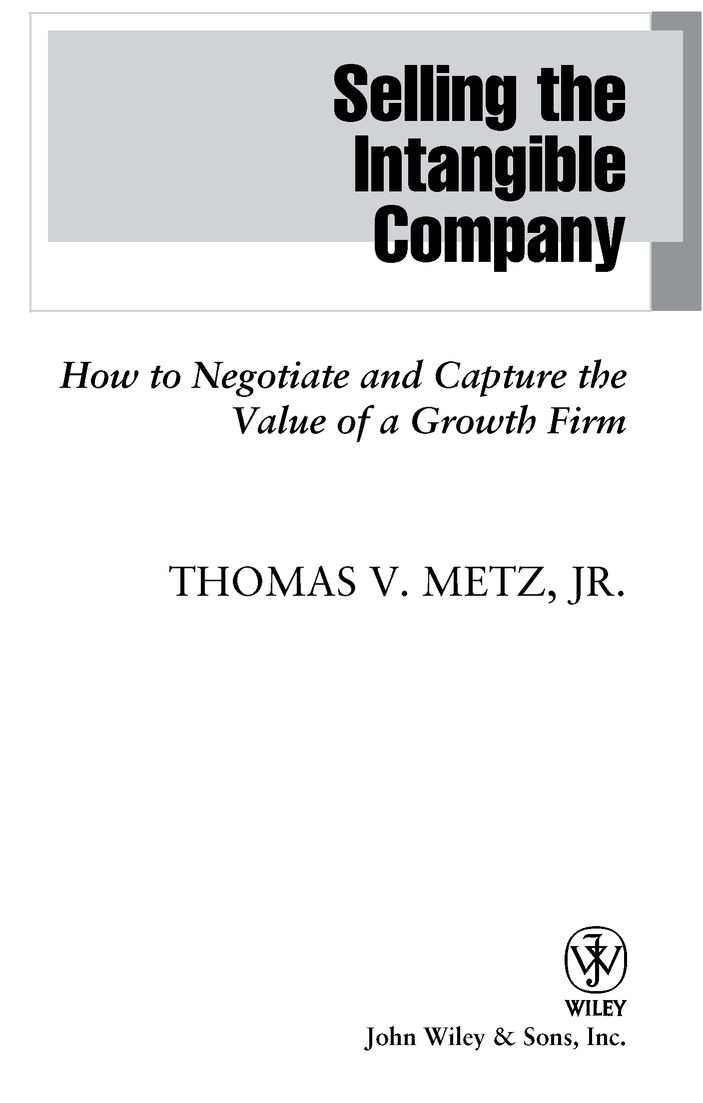Table of Contents
Praise for Selling the Intangible Company
This is an encyclopedic work that deserves multiple readings. I found a great number of familiar situations in the book from my many years as a high-tech company executive. An excellent resource for anyone considering the sale of their company.
Phil Herres, President, Haydrian Corporation
Toms book reveals the secrets of how entrepreneurs can get the most value for their business at the best time. Anyone who does not read it will leave a lot of money on the table when they sell.
John R. Castle, Sc.D., Lecturer in Entrepreneurship,
Foster School of Business, University of Washington
Selling the Intangible Company is a comprehensive resource that describes not only the technical issues associated with valuing, marketing and selling a business, but also the interests and biases of those who influence the process. This is a must read for entrepreneurs, chief executives and their key advisors.
Douglas W. Brown, President and CEO, All Star Directories, Inc.
Founded in 1807, John Wiley & Sons is the oldest independent publishing company in the United States. With offices in North America, Europe, Australia and Asia, Wiley is globally committed to developing and marketing print and electronic products and services for our customers professional and personal knowledge and understanding.
The Wiley Finance series contains books written specifically for finance and investment professionals as well as sophisticated individual investors and their financial advisors. Book topics range from portfolio management to e-commerce, risk management, financial engineering, valuation and financial instrument analysis, as well as much more.
For a list of available titles, visit our web site at www.WileyFinance.com.
With gratitude, I dedicate this book to my parents,
Joanie and Tom.
Preface
I have always been intrigued by doing deals. When I was a young man I would sell my current car for a profit and figure out a way to get a good deal on a newer car. I was very tuned in to the market and I could spot a bargain. A deal is a deal. A small deal is just as exciting as a big deal. The fee is not as large, but the problems are just as real and often more difficult. Sometimes small deals require solutions that are much more creative.
Selling the intangible is a natural extension of this interest. The value of many technology and software companies is intangible; it is based on their software and technology, not on the companys earnings. This is a challenge when selling a company, because there is no way to effectively value the firm. So how do you negotiate the sale of a company when the value is intangible? You will find the answers in this book.
I have been selling technology and software companies for more than 25 years and have managed more than 100 transactions as the chief negotiator. This narrow specialty has enabled me to work with clients all over the worldincluding North America, Europe, and Asia. In selling companies I have tried a variety of approaches and techniques in an attempt to determine the best way to sell companies whose value is strategic. Sometimes these methods may appear contrary to conventional wisdom in the merger and acquisition business. In many cases I started my approach using typical methods but discovered that they were not very successful. So I had to go back to the drawing board and find other ways to be effective in closing those transactions.
I have always gravitated towards philosophical thinking. It intrigues me to figure out why things are the way they are and to postulate some overarching theory that can help explain matters. Sometimes it leads me to discover a better way to do things. At the same time, I consider myself a very practical person, so my approach to investment banking is a pragmatic one, guided by a philosophy or a set of principles that help me deal with the realities of the market.
Perception is more important than analysis when selling a company that has strategic value. Many CEOs of technology companies have strong analytical skills and they place a lot of stock in these abilities. In my experience, perception is the hard part. Perception means clearly seeing the market as it is. It means perceiving the real needs of the buyers. It means perceiving the nuances and subtleties in the midst of negotiations.
This book is designed to help entrepreneurs, venture capitalists, and CEOs to better understand the process and nuances of selling a company whose value is strategic. It addresses the issues surrounding the sale of a company in which the value is in its technology, its software, and its know-how, and has not yet shown up in earnings or on its balance sheet.
The target audience for the book includes entrepreneurs, CEOs, and boards of directors of companies with strategic value that will one day need to sell. Venture capitalists, founders, and individual shareholders should also benefit from the concepts in this book. Lastly, I think that attorneys, accountants, and other professionals involved in the transaction will find this book informative.
There are a number of good books on mergers and acquisitions. Many are written by attorneys and academics and they do a fine job of describing the structuring and legal aspectspurchase agreement, transaction structure, letter of intent, due diligence, and so on. Many include checklists and sample agreements which are helpful. My observation is that CEOs and venture capitalists have a good understanding of the overall process of selling a company, but that some of the nuances and subtleties of selling an intangible company are missed. Few books address the sale of a company from the market perspective, which addresses questions such as: Why are adjacent markets important? In which sectors can the best buyers be found? How will a buyer view the acquisition? How does the buyer perceive value? These are questions that I explore in the book.
Almost every business will transfer ownership at some point in time. Only a small fraction will actually complete a public offering. The vast majority of companies will achieve liquidity for their shareholders through a sale of the company.
Acquisitions can have strategic or financial motivations. A financially motivated transaction is one in which the price is based on the companys record of profits. The buyer is purchasing a stream of profits in the future and the value can be calculated using standard valuation methods. A strategic transaction is one in which the buyer makes the acquisition because of the targets special capabilities, technology, or know-how.
In a sense, all deals are strategic; however there are different degrees of strategic. An industry consolidation acquisition is not as strategic as the acquisition of a company to gain key technology or to penetrate a new market. Strategic value is a moving target. This is one of the reasons that selling these kinds of companies is so interesting.
My perspective is that of a boutique investment banker and my role is to manage the process and get the deal closed at the best price with the best buyer. Throughout my career, working with entrepreneurs is one of the aspects that has been the most fulfilling. I have great respect for entrepreneurs. It takes courage, because the possibility of failure is all too real. Entrepreneurs do not take the easy road. They can be stubborn and difficult to deal with; but they are terrific.


